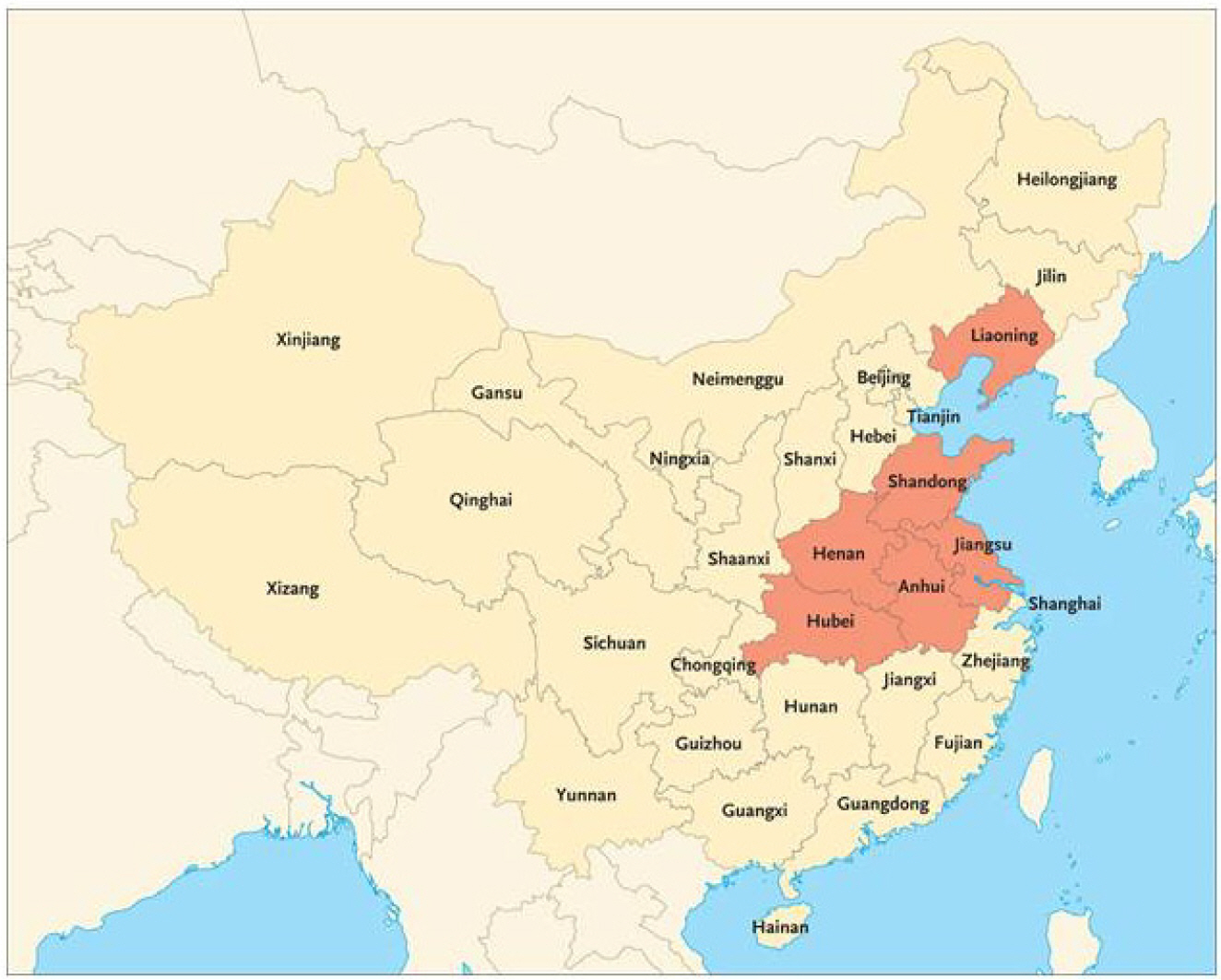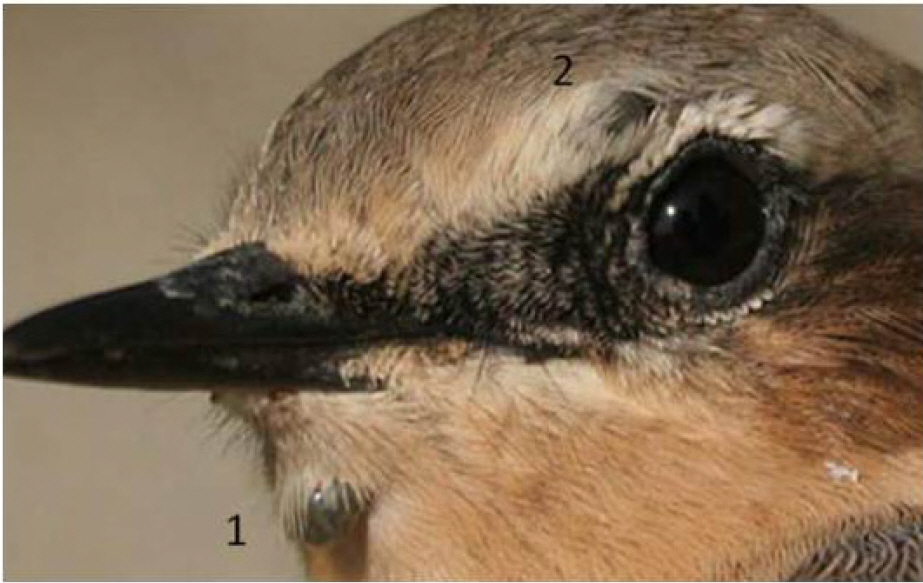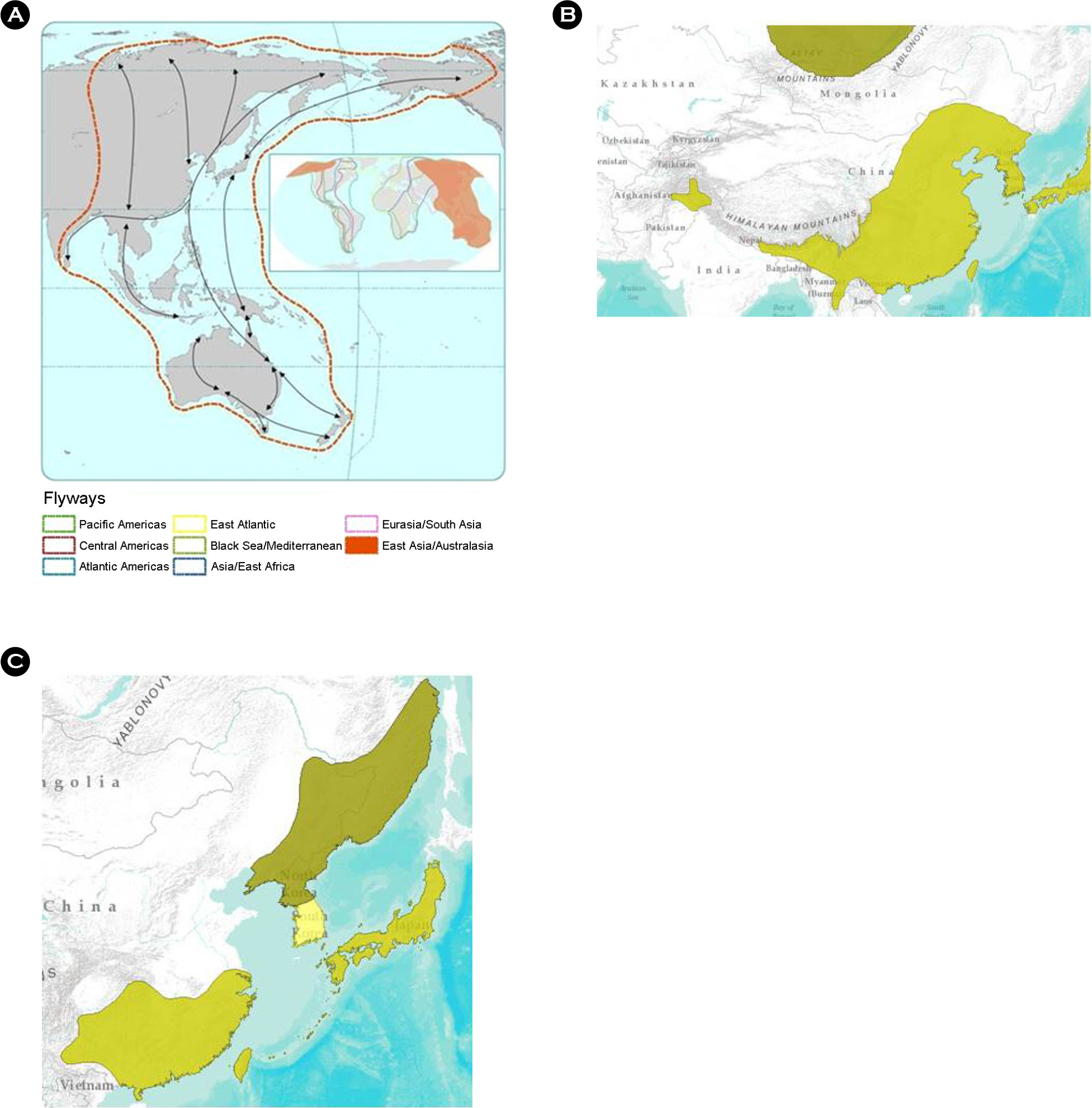J Bacteriol Virol.
2013 Dec;43(4):235-243. 10.4167/jbv.2013.43.4.235.
Severe Fever with Thrombocytopenia Syndrome Virus, Crimean-Congo Haemorrhagic Fever Virus, and Migratory Birds
- Affiliations
-
- 1Department of Microbiology and Immunology, Jeju National University School of Medicine, Jeju, Korea. yomust7@jejunu.ac.kr
- 2Medical Entomology & Zoonoses Ecology, Microbial Risk Assessment, Emergency Response Department, Public Health England, Porton Down, Wiltshire SP4 0JG, UK.
- 3Department of Internal Medicine, Jeju National University School of Medicine, Jeju, Korea.
- KMID: 1501991
- DOI: http://doi.org/10.4167/jbv.2013.43.4.235
Abstract
- Severe Fever with Thrombocytopenia Syndrome (SFTS) and Crimean-Congo Haemorrhagic Fever (CCHF) are tick-borne diseases belonging to the family Bunyaviridae. Since SFTS was first reported in China in 2009, the virus was isolated and confirmed in 2011, with additional reports of SFTSV expanding its geographic range from China to South Korea and Japan. CCHFV has the widest geographic distribution of any tick-borne virus, encompassing around 30 countries from eastern China through Asia, the Middle East, and southeastern Europe to Africa. During the past decade, CCHFV has emerged in new areas of Europe, Africa, the Middle East, and Asia and has increased in endemic areas. Migratory birds are considered to play a role in dispersing CCHFV vectors, and the virus. This review summarises SFTSV and CCHFV, highlighting the role of migratory birds in the transmission of tick-borne disease.
Keyword
MeSH Terms
Figure
Cited by 3 articles
-
Epidemiology of severe fever and thrombocytopenia syndrome virus infection and the need for therapeutics for the prevention
Norbert John C. Robles, Hae Jung Han, Su-Jin Park, Young Ki Choi
Clin Exp Vaccine Res. 2018;7(1):43-50. doi: 10.7774/cevr.2018.7.1.43.The First Case of Non-retrospective Clinical Identification of Severe Fever with Thrombocytopenia Syndrome Patient in 2013 in South Korea
Sang Taek Heo, Jeong Rae Yoo, Keun Hwa Lee, Kwan Soo Ko
J Bacteriol Virol. 2015;45(2):155-158. doi: 10.4167/jbv.2015.45.2.155.Outbreak of Zika Virus
Jong Jin Woo, Jeong hoon Bae, Ji-Hoon Kang, Keun Hwa Lee
J Bacteriol Virol. 2016;46(4):330-334. doi: 10.4167/jbv.2016.46.4.330.
Reference
-
1). Palomar AM, Santibáñez P, Mazuelas D, Roncero L, Santibáñez S, Portillo A, et al. Role of birds in dispersal of etiologic agents of tick-borne zoonoses, Spain, 2009. Emerg Infect Dis. 2012; 18:1188–91.
Article2). Lindeborg M, Barboutis C, Ehrenborg C, Fransson T, Jaenson TG, Lindgren PE, et al. Migratory birds, ticks, and crimean-congo hemorrhagic fever virus. Emerg Infect Dis. 2012; 18:2095–7.
Article3). Choi CY, Kang CW, Kim EM, Lee S, Moon KH, Oh MR, et al. Ticks collected from migratory birds, including a new record of Haemaphysalis formosensis, on Jeju Island, Korea. Exp Appl Acarol. 2013.4). Waldenström J, Lundkvist A, Falk KI, Garpmo U, Bergström S, Lindegren G, et al. Migrating birds and tickborne encephalitis virus. Emerg Infect Dis. 2007; 13:1215–8.
Article5). Yu XJ, Liang MF, Zhang SY, Liu Y, Li JD, Sun YL, et al. Fever with thrombocytopenia associated with a novel bunyavirus in China. N Engl J Med. 2011; 364:1523–32.6). Niu G, Li J, Liang M, Jiang X, Jiang M, Yin H, et al. Severe fever with thrombocytopenia syndrome virus among domesticated animals, China. Emerg Infect Dis. 2013; 19:756–63.
Article7). Ko S, Kang JG, Kim SY, Kim HC, Klein TA, Chong ST, et al. Prevalence of tick-borne encephalitis virus in ticks from southern Korea. J Vet Sci. 2010; 11:197–203.
Article8). Moon BC, Jeong JH, Choi YJ, Kim JE, Seo HJ, Shin EH, et al. Detection and identification of the Spotted Fever Group Rickettsial agents from Haemaphysalis ticks in Jeju Island, Korea. J Bacteriol Virol. 2009; 39:317–27.9). Oh JY, Moon BC, Bae BK, Shin EH, Ko YH, Kim YJ, et al. Genetic identification and phylogenetic analysis of Anaplasma and Ehrlichia species in Haemaphysalis longicornis collected from Jeju Island, Korea. J Bacteriol Virol. 2009; 39:257–67.10). Chong ST, Kim HC, Lee IY, Kollars TM Jr, Sancho AR, Sames WJ, et al. Seasonal distribution of ticks in four habitats near the demilitarized zone, Gyeonggi-do (Province), Republic of Korea. Korean J Parasitol. 2013; 51:319–25.
Article11). Kang JG, Kim HC, Choi CY, Nam HY, Chae HY, Chong ST, et al. Molecular detection of Anaplasma, Bartonella, and Borrelia species in ticks collected from migratory birds from Hong-do Island, Republic of Korea. Vector Borne Zoonotic Dis. 2013; 13:215–25.12). The IUCN Red List of Threatened Species, Turdus naumanni and Turdus pallidus. http://www.iucnredlist.org.13). www.birdskorea.org14). East Asia/Australasia Flyway - BirdLife International.15). Deng B, Zhang S, Geng Y, Zhang Y, Wang Y, Yao W, et al. Cytokine and chemokine levels in patients with severe fever with thrombocytopenia syndrome virus. PLoS ONE. 2012; 7:e41365.
Article16). Kim KH, Yi J, Kim G, Choi SJ, Jun KI, Kim NH, et al. Severe Fever with thrombocytopenia syndrome, South Korea, 2012. Emerg Infect Dis. 2013; 19.
Article17). Wu Y, Gao GF. Severe fever with thrombocytopenia syndrome virus expands its borders. Emerging Microbes & Infections. 2013; 2:e36.
Article18). Prevention of severe fever with thrombocytopenia syndrome. The Korea Centers for Disease Control and Prevention. 2013. http://www.cdc.go.kr/CDC/intro/CdcKrIntro0201.jsp?menuIds=HOME001-MNU0005-MNU0011&fid=21&q_type=&q_value=&cid=21368&pageNum=.19). Saitou N, Nei M. The neighbor-joining method: a new method for reconstructing phylogenetic trees. Mol Biol Evol. 1987; 4:406–25.20). Oh WS, Heo ST, Kim SH, Choi WJ, Han MG, Kim JY. Plasma exchange and ribavirin for rapidly progressive severe fever with thrombocytopenia syndrome. Int J Infect Dis. 2013. S1201–9712.
Article21). Lindeborg M, Barboutis C, Ehrenborg C, Fransson T, Jaenson TG, Lindgren PE, et al. Migratory Birds, Ticks, and Crimean-Congo Hemorrhagic Fever Virus. Emerg Infect Dis. 2012; 18:2095–7.
Article22). Palomar AM, Portillo A, Santibáñez P, Mazuelas D, Arizaga J, Crespo A, et al. Crimean-Congo hemorrhagic fever virus in ticks from migratory birds, Morocco. Emerg Infect Dis. 2013; 19:260–3.23). Ergonul O. Crimean-Congo hemorrhagic fever virus: new outbreaks, new discoveries. Curr Opin Virol. 2012; 2:215–20.
Article24). Hoogstraal H. The epidemiology of tick-borne Crimean-Congo hemorrhagic fever in Asia, Europe, and Africa. J Med Entomol. 1979; 15:307–417.25). Anagnostou V, Papa A. Evolution of Crimean-Congo Hemorrhagic Fever virus. Infect Genet Evol. 2009; 9:948–54.
Article26). Jameson LJ, Morgan PJ, Medlock JM, Watola G, Vaux AG. Importation of Hyalomma marginatum, vector of Crimean-Congo haemorrhagic fever virus, into the United Kingdom by migratory birds. Ticks Tick borne Dis. 2012; 3:95–9.27). Hoogstraal H, Kaiser MN, Traylor MA, Gaber S, Guindy E. Ticks (Ixodoidea) on birds migrating from Africa to Europe and Asia. Bull World Health Organ. 1961; 24:197–212.28). Lee SH, Nam KW, Jeong JY, Yoo SJ, Koh YS, Lee S, et al. The Effects of Climate Change and Globalization on Mosquito Vectors: Evidence from Jeju Island, South Korea on the Potential for Asian Tiger Mosquito (Aedes albopictus) Influxes and Survival from Vietnam Rather Than Japan. PLoS ONE. 2013; 8:e68512.29). Hurlbert AH, Liang Z. Spatiotemporal Variation in Avian Migration Phenology: Citizen Science Reveals Effects of Climate Change. PLoS ONE. 2012; 7:e31662.
Article
- Full Text Links
- Actions
-
Cited
- CITED
-
- Close
- Share
- Similar articles
-
- Two Cases of Severe Fever with Thrombocytopenia Syndrome Manifested with Hemophagocytic Lymphohistiocytosis Successfully Treated with Steroids
- No Detection of Severe Fever with Thrombocytopenia Syndrome Virus from Ixodid Ticks Collected in Seoul
- Severe Fever with Thrombocytopenia Syndrome
- A Case of Unusual Clinical Course in Patient with Hemorrhagic Fever with Renal Syndrome Associated with Secondary Amyloidosis
- Dengue Hemorrhagic Fever Developed after Traveling Vietnam





